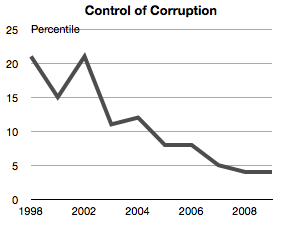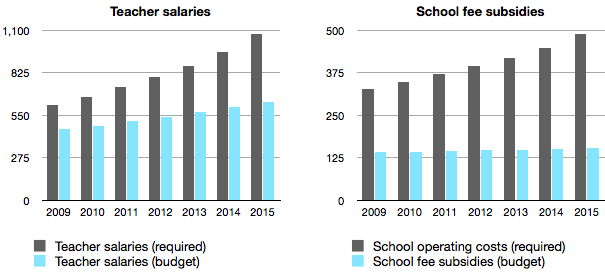 Papua New Guinea has no shortage of plans, visions, strategies and policy papers. Some are good, some are bad. All suffer from poor implementation. Despite the plans, and despite PNG’s mineral booms, the sad truth is that Papua New Guinean incomes, adjusted for inflation, have barely risen since independence.
Papua New Guinea has no shortage of plans, visions, strategies and policy papers. Some are good, some are bad. All suffer from poor implementation. Despite the plans, and despite PNG’s mineral booms, the sad truth is that Papua New Guinean incomes, adjusted for inflation, have barely risen since independence.
We are told that government’s new plan is going to change all that – incomes will increase by one third from K3430 this year to K4638 by 2015. (Actually, it’s not clear how much of the increase will be due to the implementation of the plan, and how much will be due to the LNG project, but that’s a question that could be asked at the 2011 budget lock-up on Tuesday 16 November.)
The 2011-15 Medium Term Development Plan (MTDP) has not yet been released, but reports in the media give an indication of what it contains. The government will spend K36 billion over five years on a range of development initiatives that will help create 315,200 extra jobs and sustain 8.5% growth per year to 2015.
MTDP initiatives include:
- Infrastructure. Upgrading of 16 national priority roads, construction of 16 “missing link” roads and construction of four additional economic corridor national roads;
- Health. Construction of 315 new aid posts; hire 50 additional doctors and 787 nurses.
- Education. 1,678 new primary and secondary schools; more than 9,800 teachers to be recruited
- Skills. 21,500 university places would be created, 6,800 technical and business college places, 8,000 teacher places, 5,000 nursing places, 3,700 vocational training institution places and improved access to internet and communication technologies; and
- Law and order. K1.1 billion funding for the sector.
This week, the PNG government will set out it’s spending plans for the next year and beyond. And there will be a lot of interest at the Budget ‘lock-up’ on Tuesday to hear the details of how the government plans to use taxpayers money.
A litmus test for the new plan will be how well it is funded. This doesn’t mean how many new initiatives the government announces, but whether the budget fully funds existing priorities and the basic services that are needed to meet the plan’s targets
1. How much does the MTDP cost and is it fully funded?
We don’t yet know what the government’s cost estimates are for the MTDP, but we do know how much elements of it cost because the numbers are in the partnership agreement that PNG and Australia signed in 2008.
- The rehabilitation and maintenance and the 16 national priority roads will cost about K4.5 billion over the next five years.
- Achieving basic education targets will require K9 billion.
- Public administration reforms, funded by Australia and reflected in PNG’s budget, were estimated at A$500 million (or K1.3 billion) over six years (2010-2015), plus
- K1.1 billion is earmarked for law and order.
So all of this already adds up to over K15 billion over the next five years.
How much will the rest of the development plan and ongoing government operations cost?
Perhaps next week the government will publish its cost estimates for the 16 “missing link” roads and four additional economic corridor national roads; the extra health facilities and personnel; and the expansion of tertiary education. (And these cost estimates will need to be built on top of the cost of existing service delivery.)
2. Will funds get to where they’re needed?
While allocating resources to development priorities is a necessary for success service delivery, it is not sufficient. Money needs to get to the frontline of service delivery: to schools, health centres, and local governments.
Yet, according to the NEFC, the sub-national levels of government that are responsible for the delivery of basic services are not getting the funding that they need. And based on budget documents, recurrent funding for provincial governments has barely increased in real terms since 2005, stagnating at about K1 billion (or K150 per person).
The funding shortfalls are similar for the sectors. While it is a bit tricky to go through the budget documents to see whether service providers in each sector are getting what they need, it is easy to check some of the key budget lines. For example, teachers salaries and school fee subsidies are are listed in the central government expenditure table in volume one of the budget. The government has already estimated how much it needs to spend on teacher salaries and school operating costs to achieve it’s education targets, so we can compare these to the budget numbers for teacher salaries and school fee subsidies (the government’s direct funding for school operating costs). The charts below shows the gaps in last year’s budget.
While funding for provinces has stagnated and funding for schools has fallen far behind need, the funding allocated to managed by the Department of Planning has shot up in recent years, reaching over K1 billion in the last budget. What guarantee does the government provide that these resources will reach front line service providers?
3. What safeguards are in place to prevent misuse of funds?
 Given the ambitions of the government’s targets and the funding gaps that need to be filled, there isn’t room for funds to go missing. Funding needs to reach service providers so that they can hire teachers, build roads, train doctors etc.
Given the ambitions of the government’s targets and the funding gaps that need to be filled, there isn’t room for funds to go missing. Funding needs to reach service providers so that they can hire teachers, build roads, train doctors etc.
There isn’t room for waste or leakage.
Yet the past performance isn’t very comforting. The Commission of Inquiry into Finance estimated that K500 million went missing between 2000 and 2006 (about 2.5% of spending over that period) – and that was just from the Department of Finance. The Inquiry highlighted a catalogue of system failures, and unless these are being addressed, we should assume that similar leakage will exist in future.
And control of corruption, according to one measure, has deteriorated sharply over the last decade, leaving PNG in the bottom 10% of countries in the world.
Misuse of funds means less money for service delivery. If only 10 toea in each Kina went missing over the next five years, that would still be a massive K3.6 billion – enough to rehabilitate and maintain the priority national roads. And every toea is enough to education 30,000 children per year. What safeguards are being put in place to make sure money doesn’t go missing?
The coming few weeks will be exciting. The government will unveil both it’s development plan and how it will fund it. The budget lock-up on Tuesday will be the first opportunity to ask Planning and Treasury about the efficacy of both the new plan and the budget. I hope there are some good answers. After all, the PNG public and businesses have a right to know how well their taxes are being spent.
Matthew Morris is a Research Fellow at the Crawford School and Deputy Director of the Development Policy Centre.



Paul raises an interesting point, which touches on an important policy issue for PNG – which is “ what should the future role of government be in delivery of essential social services”.
The government in PNG has traditionally been responsible for policy, regulation, standard setting, funding and service provision (although much of the rural health services have been, de facto, sub-contracted to churches to provide).
In several countries, the funding, policy and regulatory roles have been separated from service provision and the provision of health care services is contracted out with external (private or public) institutions. The role of government changes from one of managing health care provision into one of purchasing health care services from different providers. The government retains certain powers, including, controlling market entry ( e.g. clinical authorisation licenses ); reviewing prices and setting minimum quality standards.
The PNG government struggles to deliver services to its rural population. It already, in effect, contracts out services to churches, and in other areas, mining companies and plantations informally step into the breach, and provide services to populations in their immediate impact areas. There is already some policy dialogue on the issue of Public Private Partnerships. The potential for a much more pluralistic approach to health service provision is worth investigation. This could include churches, NGOs, mining and resource companies, and private health providers. However, it is not without risk – as cost escalation can be an unintended consequence if payment mechanisms and incentives are not carefully thought through. In addition government capacity to design, implement and monitor contracts would be needed.
I agree with the analysis by Matthew Morris, especially the misuse of funds and the impact these monies would have in bridging the missing funding gaps.
But I believe the biggest problem is the lack of basic financial service capacity in the rural areas to transfer public funds for procurement of public goods and services on a timely basis.The current procurement policy for service sectors like public hospitals in the provinces to rural health centres and the same for the education sector needs a complete overhaul.The key is to get the funding out to the rural areas quickly without delay so that we can purchase the much need medicine and school materials like text books on time.
One of the solution I believe would be to look at outsourcing procurement of public and donor funded services to private service providers like NGOs, Churches and the private sector for a fee.These service providers can obtain competitive quotes from existing suppliers and submit to the approved financial delegates for approval. Once approval is granted,Purchase Orders can raised and goods can be ordered and delivered in a timely manner.This would avoid leakages and misuse of funds by the many layers of bureaucracy.
Thanks,
Paul K.Martin
Port Moresby,NCD
PNG